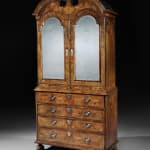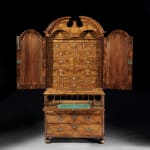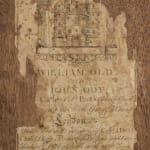Cabinets & Desks
A GEORGE I WALNUT AND BURR WALNUT SECRETAIRE-CABINET BY OLD & ODY
Width: 43" / 109.2cm
Depth: 20.5" / 52.1cm
Further images
Provenance
Private Collection: New York, USALiterature
Christopher Gilbert, A Pictorial Dictionary of Marked London Furniture 1700-1840 (Woodbridge, 1996), pp. 358-360, figs. 699-703
Publications
A very similar labeled example of similar form, but with flat cornice and bracket feet, is illustrated Christopher Gilbert, A Pictorial Dictionary of Marked London Furniture 1700-1840 (Woodbridge, 1986), fig. 600
Furniture retaining the paper trade label of William Old and John Ody is very rare, with only five pieces in addition to the present cabinet currently identified. Of this five, four are other pieces of high-quality case furniture, with two secretaire-cabinets and a bureau-bookcase. These and a bachelor’s chest, as well as the firm’s label itself, identical to that pasted onto a drawerbottom of the present cabinet, are documented.1 The fifth labelled article is a pair of chairs, now in the Museum of the Home, London (14/2006).2
The cabinet is architectural in conception, featuring a cavetto-moulded arched cornice of the type that surmounted the doors and windows of newly-fashionable Neo-Palladian buildings. It centres a pedestal for a finial. The mirrored doors are similarly arched. The original plates are bevelled and engraved with a star and retained within a crossgrain ovolo moulding, above a wide candle slide and a substantial waist moulding of cyma recta profile.
The classical form and porportions of the cabinet are completed by a square chest of four long drawers above a cyma recta base moulding and bun feet. The drawers are faced in magnificent tightly-figured burr veneers which are feather- and cross-banded in a panelled or eight short drawers design. They are contained within double bead carcase mouldings and mounted with shaped brasses.
The mirrored doors open to reveal a fitted interior of burry drawers and hinged compartments similarly banded and within double half-round mouldings, mounted with shilling-plate ring handles. The view of the reverse of the left hand door shows the substantial lock bolt. The secretaire drawer contains an arrangement of drawers and pigeon holes, below an elegantly shaped valance, and a green silk-lined writing surface.
Formed around 1717, the partnership drew on William Old’s skills as a turner and John Ody’s as a joiner/cabinet-maker to cover a larger market. The combination of chair and cabinet-making was a common one in the early eighteenth-century. The partnership was cemented, as so many were in this period, by Ody’s marriage to Old’s daugher Mary in 1717, marking the expansion of the business which now offered both veneered case furniture and chairs.3
1 C. Gilbert, Pictorial Dictionary of Marked Furniture 1700-1840 (Leeds, 1996), pp. 358-60, figs. 699-703
2 A. Bowett, Early Georgian Furniture 1715-1740 (Woodbridge, 2009), p.160, pl. 4:30
3 Lindey, ‘William Old and John Ody ‘At the Castle in St Paul’s Church-Yard’’, FHS Newsletter (Feb. 2006)





